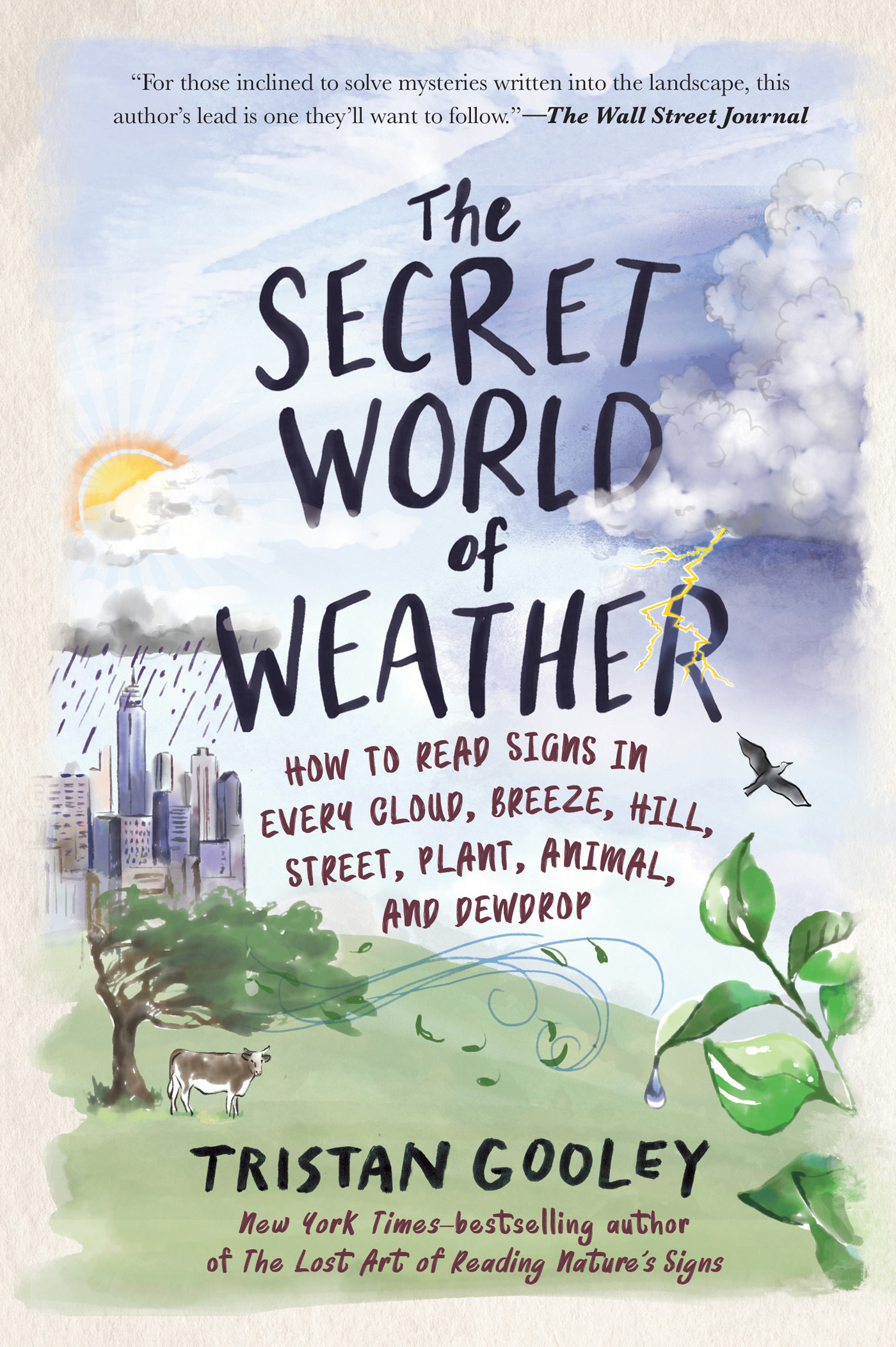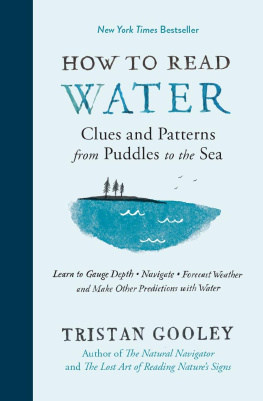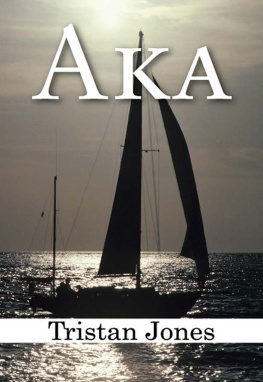Tristan Gooley - The Secret World of Weather
Here you can read online Tristan Gooley - The Secret World of Weather full text of the book (entire story) in english for free. Download pdf and epub, get meaning, cover and reviews about this ebook. year: 2021, publisher: The Experiment, genre: Home and family. Description of the work, (preface) as well as reviews are available. Best literature library LitArk.com created for fans of good reading and offers a wide selection of genres:
Romance novel
Science fiction
Adventure
Detective
Science
History
Home and family
Prose
Art
Politics
Computer
Non-fiction
Religion
Business
Children
Humor
Choose a favorite category and find really read worthwhile books. Enjoy immersion in the world of imagination, feel the emotions of the characters or learn something new for yourself, make an fascinating discovery.

- Book:The Secret World of Weather
- Author:
- Publisher:The Experiment
- Genre:
- Year:2021
- Rating:4 / 5
- Favourites:Add to favourites
- Your mark:
- 80
- 1
- 2
- 3
- 4
- 5
The Secret World of Weather: summary, description and annotation
We offer to read an annotation, description, summary or preface (depends on what the author of the book "The Secret World of Weather" wrote himself). If you haven't found the necessary information about the book — write in the comments, we will try to find it.
The Secret World of Weather — read online for free the complete book (whole text) full work
Below is the text of the book, divided by pages. System saving the place of the last page read, allows you to conveniently read the book "The Secret World of Weather" online for free, without having to search again every time where you left off. Put a bookmark, and you can go to the page where you finished reading at any time.
Font size:
Interval:
Bookmark:


For Sophie, on our 30/20 Anniversary.
Thank you for always being there,
whatever the weather.
To see additional images of this books concepts as they appear in the wild, please visit: naturalnavigator.com/news/tag/secret-world-of-weather.
This is an unorthodox book about the weather.
My investigation sidesteps the charts on screens and instead focuses on the clues we find as we walk around a tree or down a streetand what they reveal to us about our present, past, and future weather. This path will take us deep into a little-explored but wonderful realm: microclimates. It is time to rejoice in small local observations and celebrate the weather signs that few notice. They are out there, in the sky and throughout our landscapes, waiting for us. Many are within touching distance.
I hope you enjoy the journey.
(Note: Unless otherwise stated, we are considering the north temperate zone, which includes most of the populated parts of Europe, North America, and Asia.)
Tristan
The Known World The Secret World The Blocking High The Tree Fan
I t was a late September day , very warm with light breezes. Summer held on to the land. I walked past an oak tree I knew well and looked out, below a bright sun, over the green hills of the South Downs. They wobbled in the heat. There were a few puffy clouds low in the sky and none higher up. Visibility was not great, but the sea was there, a dull dark band in the distance.
It was Thursday, and we wanted to go for a family picnic on the weekend. I felt the breeze on the nape of my neck, looked back at the oak and its shadow, and knew then that the weather would hold. I could see the perfect spot for the picnic on Sunday.
There are several clues and two signs contained in this short, plain story. In different ways each can help us to understand what the weather has done and will be doing. But more important, they show us the way into the secret world of weather.
Weather forecasts have gained a bad name, and it started early. Robert FitzRoy, a nineteenth-century vice admiral in the Royal Navy, was a weather pioneer and the person who coined the word forecast. His reward for attempting to forge new methods in a difficult area? The public bombarded him with criticism following any incorrect forecast. It was hard to bear. FitzRoy grew depressed, and took his life in 1865.
He was ahead of his time. In the same year that he committed suicide, the learned bods at the Royal Society offered their thoughts on weather forecasting: We can find no evidence that any competent meteorologist believes the science to be at present in such a state as to enable an observer to indicate day by day the weather to be experienced in the next forty-eight hours.
One hundred years later, by the mid-twentieth century, weather forecasts were routine, but doubts lingered. The chief forecaster at Central Forecasting Station in Dunstable, Bedfordshire, sounded less than confident in 1955: Very little degree of accuracy can be guaranteed for any forecast issued more than twenty-four hours ahead.
And yet, seventy years later, it takes only seconds to find several forecasts that claim to know what our weather will be doing in ten days time. How so? Did we grow better at learning to read the signs in the sky? In a word, no.
Over the past century, there has been a revolution in four areas: We have much more plentiful and accurate data, a better understanding of the processes that govern weather, formidable data-crunching machines, and swift communication. Readings from across the globe and at every level, from high in the atmosphere to the temperature of the sea, are plugged into computers that spit out their prognostications.
Communication is more important than we might guess. It doesnt do any good to measure the air pressure in the middle of the Atlantic if it leads to a forecast that takes a fortnight to reach someone on this side of the ocean. Its hard to believe that less than a century ago many people in coastal areas relied on cones being hoisted up a mast to warn them that gales were on their way. Even if somebody had cracked a way to forecast the weather accurately a few days ahead, it would take too much cone-hoisting to send the message across a territory.
There are moments when we can look back to see the shift happening, sometimes all too slowly for the poor souls who witnessed the weather. Shortly before the Second World War, a gale rose over a previously calm sea off the west coast of Ireland. Forty-four fishermen died soon afterward. Many miles away forecasters had predicted the storm and issued warnings by radio, but they did not reach as far as the islands off County Mayo.
I have mentioned ten-day forecasts. There is a big difference between making forecasts and making dependable ones. Experience leads me to believe that even the mighty supercomputers struggle beyond five days: Their bold predictions become markedly less reliable by days six and seven. Now, though, we are at the stage when a five-day forecast has value. Two decades ago I gave little time to forecasts that ranged beyond three days. Things are improving quickly and in many areas, but not all.
The developments in professional forecasting have led to a strange relationship between ourselves and the weather. First, most people have lost the belief that we can look at the weather as the source of its own forecast. Second, weather has become detached from its home: the land.
There is now an imbalance between how professionals describe weather and how we experience it. You will have noticed that TV and internet forecasts contain vast swirls that cover entire regions. It might take five hours to drive across a single forecast region, yet we experience weather on a much smaller scale.
If a meteorologist speaks of showers in conversation, I like to ask whether it will rain in my back yard. This often prompts a laugh, because they know all too well where Im going: They know the limits of their approach. If the hundred best meteorologists in the world borrowed a hundred of the worlds most powerful computers, they would still struggle to work out exactly where a predicted shower will fall tomorrow. And they will concede total defeat if they dont know the landscape intimately. These are wise people and they are doing amazing things, but when it comes to the scale in which we actually experience the weather, they are up against it. A forty-eight-hour forecast was deemed impossible in 1865, and forecasting accurately on a small scale remains impossible for computers that dont know the land.
The same need not be true for those of us who rely on our senses. We may struggle to predict shifts in weather trends five days ahead, but we can often tell exactly where rain will fall later in the day. We have an unfair advantage over meteorologists in this game for two reasons. First, they are catering to thousands over a wide area, while we are more interested in how the weather affects us than how it affects anyone in a neighboring county. Second, they treat the weather mainly as an atmospheric phenomenon, but we experience it as creatures of the land it envelops.
A person sensitive to their landscape is granted powers of understanding denied to machines.
Font size:
Interval:
Bookmark:
Similar books «The Secret World of Weather»
Look at similar books to The Secret World of Weather. We have selected literature similar in name and meaning in the hope of providing readers with more options to find new, interesting, not yet read works.
Discussion, reviews of the book The Secret World of Weather and just readers' own opinions. Leave your comments, write what you think about the work, its meaning or the main characters. Specify what exactly you liked and what you didn't like, and why you think so.



